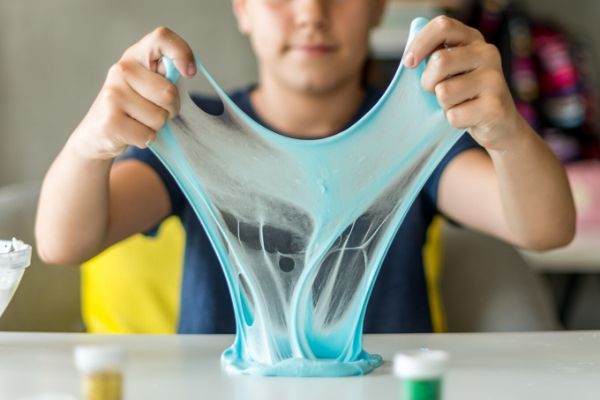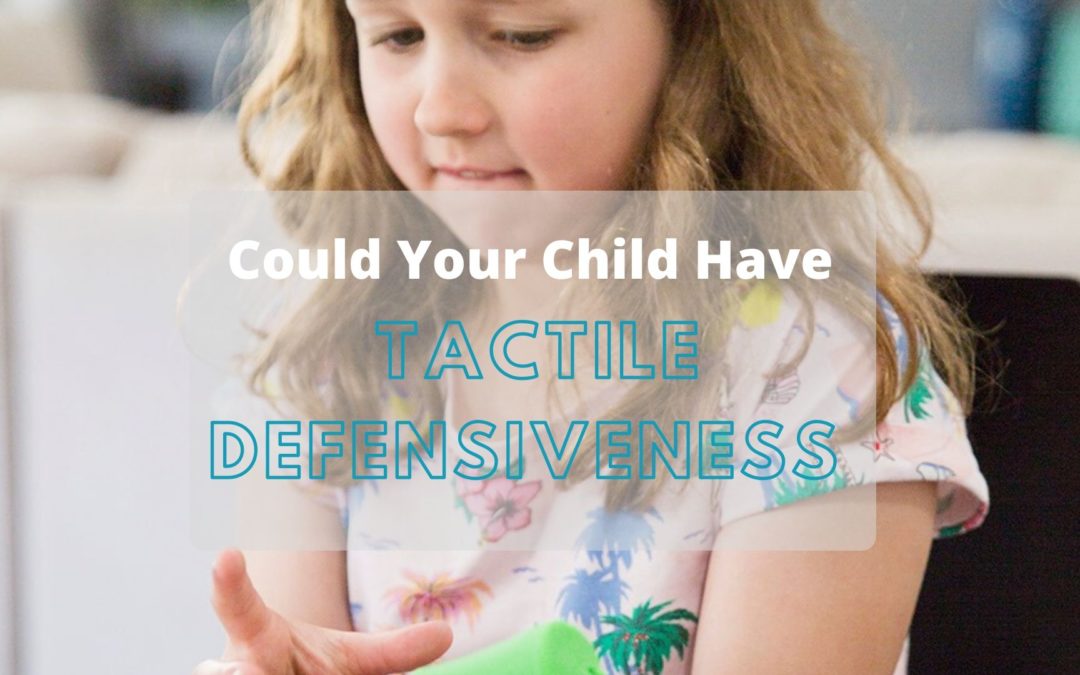As an Occupational Therapist, I often work with children with tactile defensiveness, a word used to describe people who are hypersensitive to tactile (touch) stimulation.
Our tactile sense is one of our bodies’ 7 senses and receives information through our skin and sends messages to our brain (the other senses are sight, hearing, taste, vestibular, interoception, and proprioception).
Things we touch might feel hot or cold, slimy or dry, rough or soft, etc. and this information is really important for the brain to function in everyday life.
What is Tactile Defensiveness?
Children who are tactile defensive frequently find ordinary textures/touch sensations (like clothing tags, the seams on socks, light touch, applying sunscreen, or sitting on the grass) to be overwhelming or even painful. These children may avoid or refuse to participate in “messy” play activities and this avoidance can impact their learning and development.
If you have a child that might have tactile defensiveness, where do you start?
Slow and steady is the best approach as well as calm and fun when using tactile activities to improve tactile defensiveness in children.
It’s important to acknowledge that certain touch sensations are very challenging for them, often setting off a fight or flight response (ever tickled anyone that hates being tickled?) so you never want to force them to touch things they don’t want to as it will make a problem much worse and can lead to anxiety.
Real-Life Example of Tactile Defensiveness
I have worked with a three-year-old boy that strongly disliked the texture of slime, something his peers were loving at preschool. However, slime to this little boy was like asking him to play with something he was finding repulsive. He would not even go near it and it was limiting his play opportunities and social relationships with his friends.
As an Occupational Therapist, I was able to explain this to his parents who initially thought he was just being silly and just needed to “get over it” (his mother later admitted she also doesn’t like to touch slime and even dislikes cracking eggs because of their runny consistency).
Over time through therapy, we were able to enable this boy to the stage where he really enjoyed slime but there were many steps along the way and initially, it began with playing with Play-Doh. The consistency of Play-Doh is much firmer and he was able to roll, squeeze, snip, and play with it very happily.
Once we had built a rapport and he felt as though he could trust me, I was able to provide some more challenging textures for him. This included adding water to the Play-Doh to make a wetter texture (we used blue Play-Doh and created icebergs in a bucket with water and plastic penguins that loved sliding down the glaciers).

We then progressed to slime and initially used Play-Doh utensils to do the cooking so he didn’t need to touch the slime initially. Then the final stage was hiding toys in the slime that he could find. Accidental touching of the slime helped desensitized his processing of the texture and he associated it with fun. We also always had some wet and dry washers nearby that we could use when needed.
Some of these strategies can be tried at home with your children or students if you are a teacher but always take your time and read the cues of the child as to whether they are happy to progress to the next stage or not. The goal is to introduce tactile experiences slowly and gradually as the child is ready to experience them, so the sensory defensive reaction is avoided.
What do you do if the problem continues?
Occupational Therapists who work with children work on a variety of everyday life skills including eating, toileting, dressing, and playing, to addressing fine motor, visual motor, and sensory processing concerns with children.
An occupational therapist can help your child decrease sensory sensitivities and improve overall sensory processing for improved daily functioning. You can find an Occupational Therapist local to you at www.otaus.com.au
This content is sponsored by Play-Doh (Hasbro) who are committed to supporting the growth and development of children through play.
Read about 6 Play-Doh Hacks here.
Read about Easy Play-Doh Ideas for Preschoolers here.
This blog was written as part of a collaboration with Hasbro (Play-Doh). I am working with Play-Doh to create a series of blog content on how to encourage child development through one of the worlds most well known and popular forms of play. Play-Doh is affordable and accessible and can be modified according to the task required. This content has been written in accordance with the guidelines as published by the Australian Health Practitioner Regulation Agency (AHPRA). This information is general in nature and should not replace professional advice or opinion given by a health professional or doctor. The children featured in this blog are my own children and not patients or clients. The photographs must not be reproduced, copied or edited without permission.




